Top News
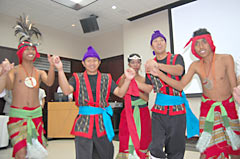
August 3, 2012 Ryukyu Shimpo
In June, ten young people from Yomitan Village and Takashiho Junior Chamber were sent to East Timor on a youth exchange program run by the Japan International Cooperation Center (JICE). On July 16, nine of them shared their experiences and impressions of East Timor on the local radio station FM Yomitan.
The program is part of the Japan-East Asia Network of Exchange for Students and Youths who aim to deepen mutual understanding among young people in East Asia. The visit to East Timor occurred from June 16 to 23, and included a performing arts exchange such as eisa, as well as a visit to Komoro Village which is famous for the production of traditional textiles.
After years of conflict, the Democratic Republic of Timor-Leste, or more commonly known as East Timor, became an independent nation in 2002. It still has serious problems to deal with such as poverty and garbage issues but with support from international institutions such as the United Nations it strives to restore order in society and develop its economy.
Tatsushi Yonaha, who went abroad for the first time, said, “I had heard that East Timor is the world’s poorest country, but I was impressed by the energy of its people. I wanted to see the world with my own eyes and learn many things.”
Katsuya Higa said, “The country is rapidly modernizing but its natural environment has been destroyed. Now may be the time to think carefully about how to provide support for this country.” Miki Hirata said, “Everybody was very friendly. This exchange opportunity made me think about learning more about Okinawan history.”
From July 20 to 25, 12 young adults from East Timor visited Okinawa on this exchange program.
(English translation by T&CT, Megumi Chibana and Mark Ealey)
Go to Japanese
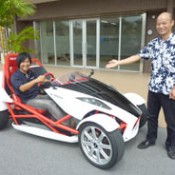
August 9, 2012 Fumiaki Jahana of Ryukyu Shimpo
The Nagoya based company AZAPA Co. Ltd, which researches and develops electronic control units in Okinawa, will commence production of an electric vehicle equipped with an electronic control unit developed within the prefecture. AZAPA plans to produce a one or two-seater electric micro compact car, which will sell for around one million yen. Enlisting the cooperation of local companies specializing in metal processing, AZAPA will commence mass-production of the vehicle in Okinawa from fiscal 2013, aiming to promote sales to resort hotels and golf courses.
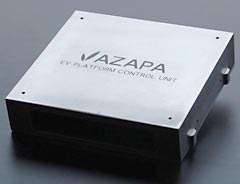
The electronic control unit for an electric vehicle.
A micro compact car is a new type of vehicle that is smaller than a standard light automobile. The Ministry of Land, Infrastructure, Transport and Tourism plans to relax standards for such vehicles within the Road Trucking Vehicle Act, and in future will allow micro compact cars to become road-taxed vehicles. Expecting the market to expand, AZAPA hopes to swiftly build a production system.
AZAPA is preparing to develop electronic control units for electric vehicles that utilize information technology. The company has commenced production of the vehicle as part of this development project and has almost finishing putting production facilities in place. At its research station in Yonabaru AZAPA is trying to develop software that can check the running of the vehicle, its battery performance and driving information such as speed and distance, as well as maintenance-related information from an iPad.
AZAPA established the research station in its Okinawa branch in November 2011, and sees Okinawa as a location suitable for developing electric vehicles and electronic control units, and promoting its projects. The reason for this is that the prefecture is working on the electric vehicle and plug-in hybrid vehicle “Town Project” that aims to develop fuel-economy cars such as electric vehicles and plug-in hybrid vehicles utilizing rechargeable batteries in people’s homes.
Saoto Tsuchiya, manager of the Research and Development Division of the research station in the Okinawa branch, said, “We plan to market these vehicles to resort hotels that may want to utilize them within their grounds. At the same time, we will continue to run tests on these vehicles, hoping to promote road-taxed micro compact cars in Okinawa.”
(English translation by T&CT, Mark Ealey)
Go to Japanese
August 8, 2012 Ryota Shimabukuro of Ryukyu Shimpo
On August 7, it was reported that 25000 barrels of Agent Orange were stored in Okinawa until 1972, the year when Okinawa returned to Japanese sovereignty. This was written in 2003 in a report issued by the Chemical Materials Agency of the Department of the Army. It is the first time that an official document from a U.S. Army-related organization has been as found that refers both to the presence of these chemicals on Okinawa, and the actual number of barrels. This may influence the stance of both the U.S. government, which has denied that it has any records of Agent Orange or other herbicides being stored or used in Okinawa, and the Japanese government, which has fit in with that position, therefore rejecting to conduct an independent investigation. Journalist Jon Mitchell, who has been investigating the issue of Agent Orange in Okinawa, disclosed the presence of the report entitled, “An Ecological Assessment of Johnston Atoll” in the Japan Times on August 7.
According to the report, the U.S. Air Force transported the defoliant to Johnston Island a year after the military commenced Operation Red Hat, in which the chemical weapons stored in the Chibana ammunition storage facility were removed to the American owned Johnston Island in 1971. According to the report, 113-tons of Agent Orange leaked into the soil of the former chemical weapons storage site in an area known as the Red Hat Area located in the northwest part of the main island of Okinawa.
The report refers to the possibility that in terms of its timing and the location, moving the barrels of Agent Orange from Okinawa to Johnston Island was a part of Operation Red Hat. A statement from the U.S. Department of Veterans Affairs (VA) in 2009 referred to military herbicides having been stored in Okinawa during the period from August 1969 to March 1972 and later disposed of in Operation Red Hat. The relationship between Agent Orange and Operation Red Hat is indicated.
According to the report, the stocks of Agent Orange were incinerated at sea in 1977 aboard the Dutch ship the Vulcanus after being taken to Johnston Island.
With regard to the issue of Agent Orange in Okinawa, in 2007 the VA admitted that some U.S. veterans were suffering from health problems due to exposure to Agent Orange that had been sprayed in the Northern Training Area. In 2011, 100 former service members sought compensation from the U.S. government for health problems caused by exposure to the defoliant while serving in Okinawa. There are concerns about health of the veterans, former base workers, and the redevelopment of land used for bases. Representatives of the municipalities that host the bases are asking the Japanese and U.S. governments to investigate the issue.
(English translation by T&CT, Mark Ealey)
Go to Japanese
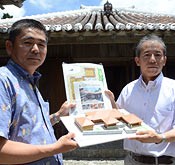
August 1, 2012 Ryukyu Shimpo
Masaru Tanaka, professor of Yamanashi University Graduate School, whose area of research is the unique architecture of Okinawa’s housing, has created a paper-craft model of the Nakamura-ke residence, an important national cultural asset located in Kitanakagusuku Village. Children can make the paper-craft model in about three hours using four sheets of paper that have a picture of building on them, plus some scissors and glue. Tanaka hopes the paper-craft model can be used as learning material in schools to teach about architectural structures.
Tanaka visited Nakamura-ke and presented ten sets of the paper craft materials to the owner, Kunihiro Nakamura. The paper craft model is one one-hundredth the actual size of the building. The rat guard sections of the tower tank and the animal shed were displayed in three-dimensional form.
Tanaka, who is a specialist in housing studies, said, “People will enjoy learning about the logic behind the room layout, which is based on Okinawa’s climate.”
Nakamura said, “I think that this could be used for free studies during the summer vacation. I hope that it will be used to help study this cultural asset.” He is also considering selling them. For inquiries, contact Masaru Tanaka at 055
(220) 8226 or at tanaka@yamanashi.ac.jp by e-mail.
(English translation by T&CT, Megumi Chibana and Mark Ealey)
Go to Japanese
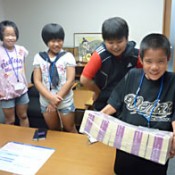
August 8, 2012 Ryukyu Shimpo
On August 7, in Naha branch of the Mizuho Bank held what they called a Children’s Summer School featuring enjoyable quizzes and games to give 12 elementary school and junior high school pupils an idea of what working in a bank is like. The children each handled a bundle of notes to the value of 100 million yen to feel how heavy it is.
They now have a better understanding of what like to work in a bank thanks to experiencing some aspects of the work involved and seeing the inside of a bank.
A staff member explained that a bank basically serves the two roles of storing and lending money, and said, “We check whether people who have borrowed money can return it or not, because the money is entrusted to the bank by people.”
Satsuki Yasue, a fifth-grade pupil of Ueda Elementary School in Tomigusuku, and her sister Natsuki, a third-grade pupil at the same school, took part in the program. Satsuki said, “I felt the weight of a bundle of notes worth 100 million yen. I now know that in a bank there are safe-deposit boxes and many security cameras to stop robbers.”
(English translation by T&CT, Mark Ealey)
Go to Japanese
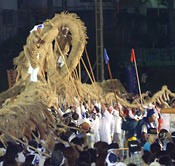
August 3, 2012 Ryukyu Shimpo
On July 27, at Okinawa International University, a traditional-style tug-of-war was held for just the second time since WWII. Representing the desire for the safety and prosperity of local people, it was revived in 2007, and having re-established itself again in the community, from now on it will take place every five years.
The tug-of-war was held between teams from the opposite sides of the main street in Ginowan – the South, “Mendakari,” against the North, “Kushindakari,” with the northern team achieving its first ever victory since the event started before the war. The atmosphere at the event was transformed into a frenzy of excitement the moment that the ropes were connected, with both teams pulling as hard as they could on the rope.
“I couldn’t be happier,” said Koshun Tokeshi, Kushindakari’s team leader. Historically, the Mendakari (southern) team has always had an advantage by attracting more participants, because the southern side of the street is closer to where the event is held, and also, so the story goes, because they use a “male rope.” After the tug-of-war the winner’s flag is raised by all of the people who took part, in what is called the murui-jina ceremony, which is unique to this event.
Before and after the pull, the hatagashira gae, a special ritual ceremony was also held to pray for fertility, and a dance was performed. Members of the Society for Performing Arts and Literature of Ryukyu from Okinawa International University also performed. Kiyoshi Nakamura, the head of the Ginowan Residents Association said, “This event was made possible thanks to the efforts in organization over a twelve-month period by a total of 900 staff and volunteers, and of course because of the large number of people who turned up to take part.”
(English translation by T&CT, Kyoko Tadaoka and Mark Ealey)
Go to Japanese
July 28, 2012 Ryukyu Shimpo
Peru is in Okinawa City – you may think that sounds a little strange, but Okinawa City is an international cultural tourism town providing a home to people from over 40 countries and mixing all sorts of cultures together. The huge U.S. military bases are not the only things that lend an international air to the city.
Peru in Okinawa City refers to Koza-Peru Kai, an association made up of people who have returned from Peru to Okinawa about half a century ago. Behind this lays the history of the migrants who went to Peru from the Meiji period through to the postwar period.
There are about 200 members, including elderly people who returned home before the war and young adults. They hold a celebration very year on July 28, the Independence Day of Peru and when they make a toast, instead of saying “Kari” in Uchinaguchi, they say “Salud” in Spanish.
Hoping to introduce to Okinawan people the Peruvian culture that their seniors have treasured through the years, they held a Peru Culture Festa in Koza on July 29. It was time to look back on the Peruvian aspect of this city.
Cynthia Higa, who helped to organize the event, left Peru when she was eight years old and she turns 31 this year. After she resolved her identity crisis between being Peruvian or Japanese, she said, “I’m proud that I am Peruvian-Japanese and of being someone who can understand both cultures.”
Uchinanchu who went to Peru from Okinawa must have the landscape of their homeland of Okinawa etched in their minds, and support each other by meeting regularly. Likewise, people from Peru living in Okinawa City also may have landscapes of Peru in their minds. Seeing Peru by my mind’s eye, I would like to propose a toast: “Salud!”
(English translation by T&CT, Lima Tokumori and Mark Ealey)
Go to Japanese
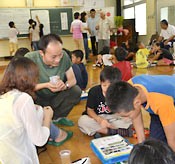
August 1, 2012 Ryukyu Shimpo
With support from the Japan International Cooperation Agency (JICA), and aiming to deepen understanding of the protection and care for local ibises and wild fowl, 12 members of the Chinese project group for protecting ibises in China visited Kijoka Elementary School in Ogimi on July 26. The school has been involved in bird-watching since 1988 and has also been engaged in activities to preserve the natural environment. The group observed wild birds in the rice fields with the children and studied the results of research.
Seven wild ibis were found in China’s Shaanxi Province in 1981, and the number of ibis has subsequently increased through artificial breeding. From then on, they started to send ibises to Japan.
However, the crop volume in areas where ibises where released decreased because farmers had to limit the use of agrichemicals. For that reason, since 2010 JICA has promoted growing cash crops in order to create an environment in which humans and ibises can coexist.
A member of the project, Kijoka resident Noritaka Ichida, who is a special adviser to Birdlife International has taught local children about bird watching. This stimulated the members of this group from China to come to look at Kijoka to get ideas about protection activities back in China.
The members read observation records and observed wild fowl with children near the school and rice paddies in the area. The school presented the results of their environment education. One member of the group asked if the number of species of birds has increased, to which a school staff member referred to the overall decline in Japan in the number of wild birds, but said, “Thanks to the efforts of farmers the number of species has not decreased here.”
(English translation by T&CT, Lima Tokumori and Mark Ealey)
Go to Japanese
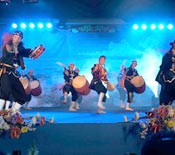
July 31, 2012 Akiko Yasuhara Correspondent of Ryukyu Shimpo
On July 29, at the Brazil Okinawa Cultural Center in Sao Paulo, a local festival was held bringing the 1st Worldwide Youth Uchinanchu Festival 2012 to an end. A total of 150 young people from seven different countries celebrated the festival being held for the 25th time.
During the performance of the Ryukyu Koku Matsuri Daiko Brazil branch in the early part of the festival, other members of overseas branches such as the United States and Argentina joined in to dance eisa together. A total of 300 people, the largest-ever number of performers at the branch, beat drums with vigor under the clear sky and an electric air to the people dancing kachashi. The Ryukyu Stomp, a dance group made up of members of the World Youth Uchinanchu Association Okinawa branch, expressed the history of Okinawan immigrants in their performance, moving to the mixture of Ryukyuan folk songs and techno music.
The audience cheered and whistled in support.
In the main event, there was a beauty pageant held in Ryukyuan dress, with participants from the three branches of Okinawa, Bolivia and Peru appearing in traditional Ryukyuan costume wearing large floral-shaped hats. Aya Toyosato from the Okinawa branch was selected among the seven finalists.
About the festival, Saori Kanashiro of the Peru branch said, “It was one big youth movement. I was able to make lots of global connections.” Shun Maeshiro of the Okinawa branch promised other participants to meet again at the festival to be held in the United States next year and said, “There are still some problems to resolve around running the event, but I’m glad to see everyone so happy. The bonds we have established here will endure into the future. I’m sure that they will bring further momentum.”
(English translation by T&CT, Lima Tokumori and Mark Ealey)
Go to Japanese
July 30, 2012 Ryukyu Shimpo
According to documents released by the U.S. Air Force Safety Center on July 29, the Air Force CV-22 Osprey vertical take-off and landing transport aircraft was involved in at least 30 Class A to C category mishaps in the seven-year period from October 2005 to June 2012. The CV-22 is the almost same type of aircraft as the MV-22 Osprey that is scheduled to be deployed to U.S. Marine Corps Futenma Air Station. Since 2006, the MV-22 has been involved in at least 31 Class A to C category mishaps, which is again testimony to the fact that accidents involving the aircraft have been occurring relatively frequently.
The breakdown of categories of accidents involving the CV-22 is included in the documents released from the U.S. Air Force Safety Center.
Three accidents have occurred in Class A mishaps, which involve a fatality, a permanent full disability or damages worth at least two million dollars. This would seem to include the crash that occurred in Florida this June. In Class B mishaps, which involve permanent partial disability or damages worth between 500000 and two million dollars, seven mishaps have occurred. In Class C, which involves a non-fatal injury or damages worth between 50000 and 500000 dollars, 20 mishaps have occurred.
With regard to the principle causes of the accidents, problems pertaining to maintenance and management of the aircraft, such as mechanical parts falling out of place during aircraft inspections and operational problems were mentioned. The U.S. authorities calculate the accident frequency rate based on the number of Class A mishaps, and the rate for the CV-22 is 13.47, and 1.93 for the MV-22.
With regard to the difference of the accident frequency rate between the two variants of the same aircraft, the center emphasized the difference in the nature of the missions assigned to these two Osprey aircraft, explaining that the Osprey carries out training under extreme conditions due to the specific missions that each aircraft is required to engage in.
At the same time, the Okinawa Prefectural Government and the Ginowan Municipal Government requested that the Okinawa Defense Bureau release the statistical data for the accident frequency rate of all the Osprey aircraft, including the CV-22. The bureau rejected this request last August, stating, “We are not at the stage of acquiring significant data about the accident frequency rate of the CV-22 because of its extremely low total flight time.”
(English translation by T&CT, Mark Ealey)
Go to Japanese
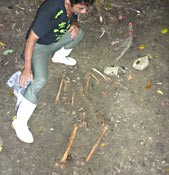
July 27, 2012 Ryukyu Shimpo
On July 27, three sets of remains were found in the Kochi area of Nishihara, which was the scene of fierce fighting during the Battle of Okinawa. They were found by Seizen Takaesu and Kobun Iha who are members of the Gamafuya volunteer group dedicated to the recovery of remains of the Battle of Okinawa. With one of the sets of remains, most of the skeleton was unearthed. On July 26, an expert confirmed it was the skeleton of an adult male. In the same area, this January seven sets of remains were found that seem to have been soldiers and young civilian personnel of the Imperial Japanese Army.
Buttons off a school uniform were found near the remains. The Chinese character symbolizing Middle School was inscribed in the center of a cherry blossom emblem on the button. Takamatsu Gushiken, a representative of the Gamafuya group, said, “It is possible that the buttons were off a uniform of the First Okinawa Prefectural Middle School (now Shuri High School).” He is thinking of asking the Yoshu Alumni Association about the remains. Gushiken pointed out that it is necessary to carefully continue collecting remains in the area.
According to Naomi Doi, an instructor at the University of the Ryukyus School of Medicine who inspected the remains, judging from the teeth of the lower jaw and the femur, the skeleton of the body that was mostly recovered seems to have been that of a young adult male about 160 centimeters tall. While its skull was missing, the skeleton was found lying on its front, with its right shoulder dislocated. The person seems to have been shot and to have had broken bones.
(English translation by T&CT, Mark Ealey)
Go to Japanese









 Webcam(Kokusai Street)
Webcam(Kokusai Street)


